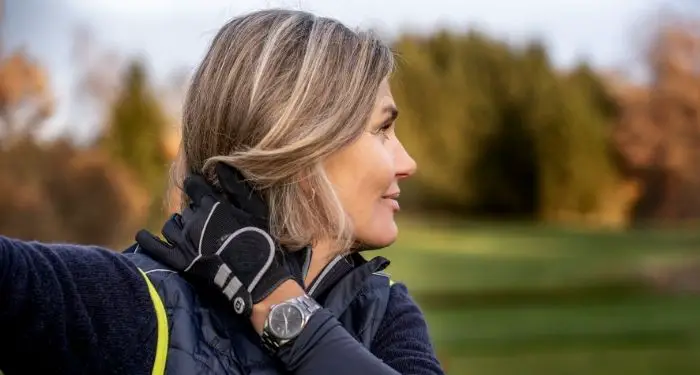Table of Contents
Hair Changes In Menopause
As we enter perimenopause and menopause, hair care changes may be necessary to keep up with our changing hormonal makeup. Transitioning to and through menopause can bring on an onslaught of both emotions and physical, changes…including changes to our hair. For most of us, our hair is an important part of our identity, and these new developments can be startling and uncomfortable.
Maybe your self-confidence has taken a bit of a hit as the process has unfolded. There are a number of means to deal with your hair post-menopause, so make sure to tune into your individual goals and do what you need to do to bring back your best self. If you’re unsure of where to start, this article provides a brief overview on how to do just that.
How Hair Changes After Menopause
The first thing women may notice about their hair is the lack of volume and length. This is due to the decrease in estrogen levels that crops up while the body undergoes its hormonal imbalances.
Your hair will also begin to break off more easily, since the hair produced by your follicles becomes thinner and finer, and thus more fragile.
Hair loss is perhaps the most profound side effect that women will notice. It may be due to genetics or brought about by menopause, but you’ll be able to pinpoint it through bare patches on the scalp and the loose strands of hair that come away when you comb through your locks.
In addition, if you’ve spent your whole life with thick, smooth hair, it might be disconcerting to wake up one day to the reality that your hair that is now thin, dry, frizzy, and looking a little lackluster. This comes as a result of your hair glands producing less oil, which leads to tresses that are drier and without elasticity.
Aging hair will also decrease its melanin production, the group of pigments responsible for giving your hair its natural color. By the time most women turn 50, at least half their heads should be partially gray. Melanin is also great for absorbing the sun’s harmful UV rays, and in its absence, your hair is essentially exposed to the sun on its own, leading to more damage.
Menopause Shampoo, Color, Conditioner
Shampoo
It’s a general consensus among hair experts that women do not need to shampoo every day. Even for those who are not undergoing menopause, excessive shampooing can strip away the natural oils produced by your hair and leave it frizzier than before. During the days that you do wash your hair, make sure to use shampoos that are meant for hair growth and other benefits.
Many brands carry products that come infused with essential nutrients and vitamins such as D3 that are created to prevent breakage and further hair loss. Another popular option is the usage of dry shampoos or leave-in formulas for the times that you decide to skip on a wash. These will give you the advantage of cleaning your scalp while not needing to style your locks with a hairdryer or curling wand after.
Dermatologists agree that while too much shampooing can be detrimental to hair health, overuse of heat rods and other tools, especially on post-menopausal hair, can make it even worse.
Color
Another decision you might have to make post-menopause is whether or not you should go completely gray. If this doesn’t appeal to you, try to lessen your trips to the salon for color sessions. The chemicals present in hair dyes are very damaging to both the hair and the scalp, and can be quite harsh on thinning hair in particular. An easy compromise to make is to also go with organic hair colors with longer breaks between services. Stick to letting the professionals work their magic on your hair instead of attempting to do it yourself, since these people will have had more experience in handling post-menopause hair. When you come in for color treatments, request a shampoo that will ensure the color stays longer while also giving your locks the vitamins needed.
Conditioner
Last but not the least: conditioner. This is an absolute must for everyone, even those with a full head of hair, but after menopause, when the hair is especially in need of some TLC, it becomes more essential. Take care to use one that is free from sulfate to preserve the natural proteins in the hair and slow the thinning process. Really massage your scalp in order to evenly spread the product and stimulate a healthy blood flow along the hairline. Once a week, consider doing an intensive hair treatment or hair mask, whether professionally done or something as simple as an egg and olive oil mixture, to rejuvenate the hair and keep it as healthy-looking and glossy as possible.
How to Keep Hair Shiny After Menopause
The most optimal means to keep your hair shiny is to keep it in prime condition. Still intent on using heat styling gadgets? Consider applying heat protection products beforehand to minimize the negative effects. Work with these tools with the heat levels not up to full capacity to protect your hair further.
Brushing your hair brings your natural oils from the roots all the way to the tips. t(Nature’s natural moisturizer.) This movement works as a second means of massaging the scalp to provide a better environment for a hair follicle to thrive in.
Something else you might want to consider is getting a color gloss every time you do your hair. This refreshes the color of your hair and adds a light-reflecting shine so that your tresses appear sleek and glowing. Avoid items such as mousse and hair sprays. The alcohol present in them dries out the hair to a matte finish. Lastly, you can also add a hair serum for an additional shine, which is then brushed out to ensure that every strand is covered.
Menopause Hair Thinning
During menopause, hair thinning becomes a fact of life due to biological, environmental, and genetic factors. As the amount of estrogen and progesterone you produce begins to wane, your hair begins to grow a bit more slowly, and becomes thinner. Stress, genetics, and the effects of aging itself play a part for all of us.
Products for Menopausal Hair Loss
There may be a number of factors that result in the type of hair loss you experience. If you are concerned, check with your doctor to make sure there are no underlying issues as the root cause. There are lots of over-the-counter products you can look at to not only strengthen and support your hair, but to help with re-growth as well. Targeted hair care product programs that I am currently using:
- Nioxin System Hair Care can really help on a daily basis. The shampoo cleans without stripping, the conditioner is light (I don’t need much on my hair skinny hair), and the scalp and hair mousse actually works to give my hair body without weight.
- Nutrafol is a hair growth supplement that I have also begun using. It’s still a little early, but it seems that it’s beginning to jack up the condition of my very fine, thin hair. The texture seems to be more supple and manageable.
- Women’s Rogaine is something I have used in the past. I can tell you it definitely worked for me. You must be consistent and diligent in using it, but for me, it was a win.
If you find that your hair is not what it used to be, there’s no reason to despair. Hair care routines may change and adapt to your new life as you grow older, but that doesn’t mean you’re doomed to have lifeless locks for the rest of time. With just a few simple changes in your regimen, you’ll find that the shine in both your hair and in you have returned without you even noticing.
Winsome To Wisdom is a participant in the Amazon Services LLC Associates Program, an affiliate advertising program designed to provide a means for sites to earn advertising fees by advertising and linking to Amazon.com


